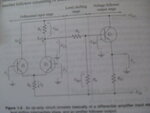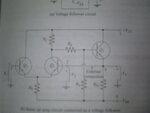jayanthyk192
Full Member level 3
Hi,
i started learning about opamps from a book by David Bell.I'm stuck up in the voltage follower cirucit(attached).i'm not able to analyze the circuit as there are too many parameters coming in.firstly the voltage V1 is increased,and according to the book the V feedback and hence V2 @ Q2 is zero.i did'nt understand this.then as the votage is increased all parameters sort of come together and makes my analysis difficult.so how do i analyze the circuit.
i started learning about opamps from a book by David Bell.I'm stuck up in the voltage follower cirucit(attached).i'm not able to analyze the circuit as there are too many parameters coming in.firstly the voltage V1 is increased,and according to the book the V feedback and hence V2 @ Q2 is zero.i did'nt understand this.then as the votage is increased all parameters sort of come together and makes my analysis difficult.so how do i analyze the circuit.

